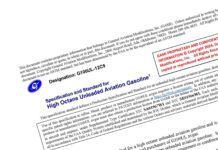The April issue of Aviation Consumer featured staff commentary entitled Unleaded Fuel: More Foot-Dragging. After that article was published, GAMI was invited to provide a firsthand update on exactly where GAMI is in the process of beginning to deploy G100UL™ avgas to the aircraft owners and pilots. Gami’s George Braly follows up here.
Initially, I want to mention that the April staff commentary was, in my judgment, an accurate analysis of the status of the two fuels that had been under scrutiny by the EAGLE/PAFI program (Lyondell/VP Racing and Phillips 66/Afton Chemical) and the still STC candidate fuel (Swift Fuels). Since the article appeared, there was a late March 2023 public briefing by the EAGLE managers who announced that the two PAFI candidate fuels had failed to pass Gate 1 on the EAGLE progress chart timeline and were going to be resubmitted after undergoing reformulation.
TWO ITEMS
On the subject of deploying G100UL avgas, the following two items keep surfacing in virtually every discussion:
1) There is a constant criticism of G100UL avgas based on uninformed claims that no large producer will make it without GAMI first obtaining an ASTM International specification; and,
2) The 2015 California judicial consent decree mentioned in the April staff report appears to require the termination of the use of 100LL after a high-octane unleaded avgas becomes commercially available. What role will that decree play in the deployment of G100UL avgas?
First: What is the “magic” claimed to be associated with or derived from an ASTM specification?
Simply put, there is none. A specification is a specification whether it is issued by ASTM or the FAA. GAMI had the option of two paths to unleaded fuel approval, certification and issuance of a specification, via ASTM or the FAA STC process. We chose the FAA route for several reasons, notably that the ASTM process associated with any new, disruptive fuel chemistry would require the approval from multiple ASTM industry members who have directly conflicting financial interests, which create a strong incentive to delay or stop any fuel candidate that would be a fleet-wide replacement for 100LL.
SPECIFICATION
The legal definition of a specification is a document designed to facilitate commerce. Yes, it is that simple. Thus a buyer can request a product by referencing the specification. There now is one for G100UL avgas. There is no requirement anywhere that an aviation fuel hold a specification issued by ASTM rather than the FAA.
Here’s what the FAA has said for decades about specifications:
“For a fuel or oil specification to be acceptable to the FAA, it must be written in sufficient detail to provide, at a minimum, the physical properties and limits by which uniform quality and composition can be maintained. The FAA has determined that this can be accomplished by performance specifications that rely on specialized test methods to ensure quality and composition.”
Bottom line: GAMI’s FAA approval of G100UL avgas precisely complies with that long-standing FAA requirement. That is how it obtained FAA approval for G100UL avgas.
Second: The Center for Environmental Health (CEH) sued a large number of 100LL distributors and FBOs in California some years ago (Case No. RG-11-600721, Alameda County, Ca.). The result of that lawsuit was a 2015 consent decree. It includes the following language:
1.10 CEH and the Settling Defendants now agree in this proposed Consent Judgment to resolve CEH’s claims in the Complaint by, (a) … and (b) ensuring that Settling Defendants distribute and sell the airplane fuel with the lowest lead content that is commercially available.
Where we are now: On April 4, 2023 the EAGLE program held a meeting in Coral Gables, Florida. At the beginning of the meeting, an EAGLE senior manager (Tim Smyth, former head of the Chicago FAA certification office, now retired) presented the results of the recent Cirrus validation flight testing on G100UL avgas (Cirrus is one of the organizations that has conducted independent testing of G100UL avgas). He reported:
“I was trusted with reviewing the GAMI data for the STC. I thank the company for trusting me with looking at that and seeing it. They didn’t have to do that. What you’re seeing here on this slide was performed with the STC process, in fact, all of it was. I think so far, we’re seeing good agreement between the STC effort and the Cirrus demonstration. It’s been very encouraging in my opinion.”
PRODUCTION
GAMI was invited to make a short presentation. During it, I revealed that one very large, international producer of aviation jet fuel had agreed to produce of G100UL avgas in large commercial quantities and was expecting to have it “commercially available” at its facility in Houston, Texas, by midsummer.
The only thing standing in the way of resolving the rapidly escalating crisis for California pilot/owners is for one or more of the existing four major distributors of 100LL to agree to send tank cars to a rail siding in Houston and begin transporting of G100UL avgas for distribution.
For more detail on this subject, please see the video of my presentation at Sun ‘n Fun which is available at: tiny.cc/t7f6vz




